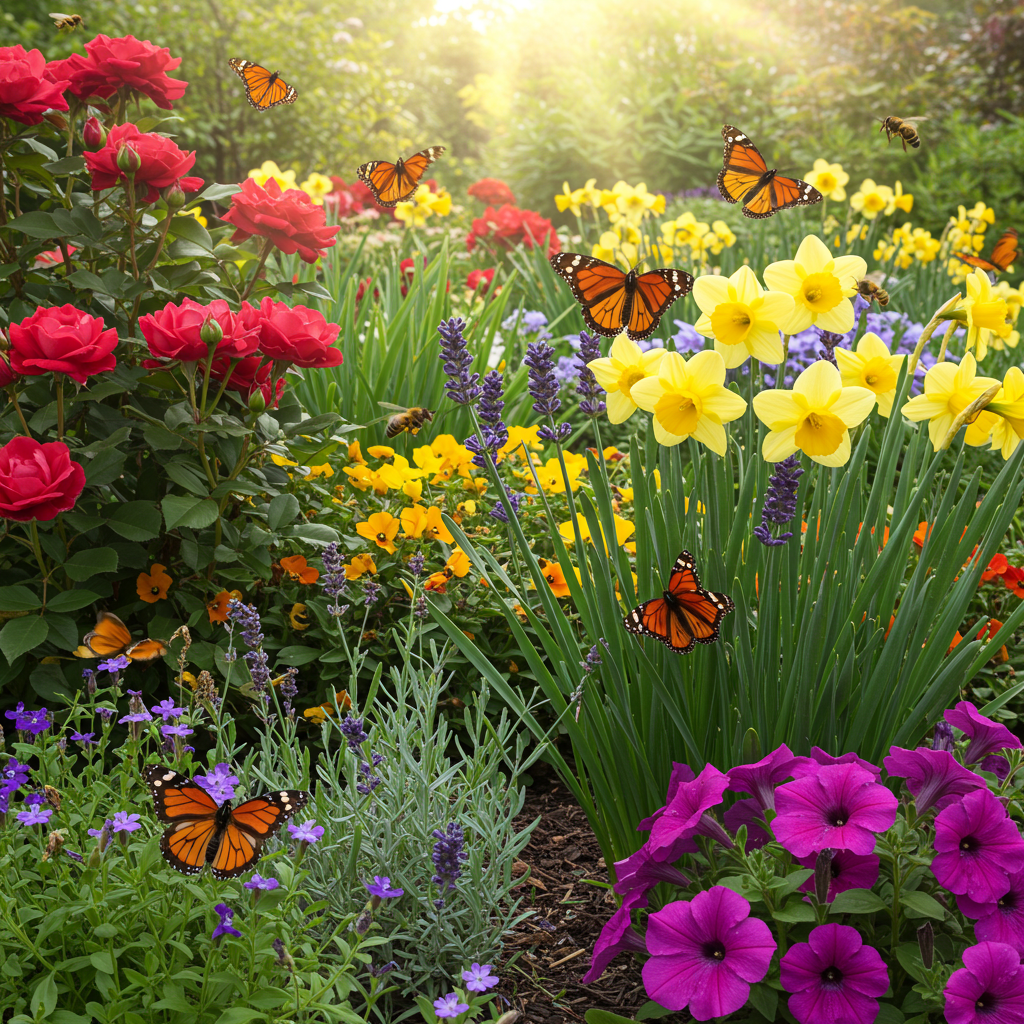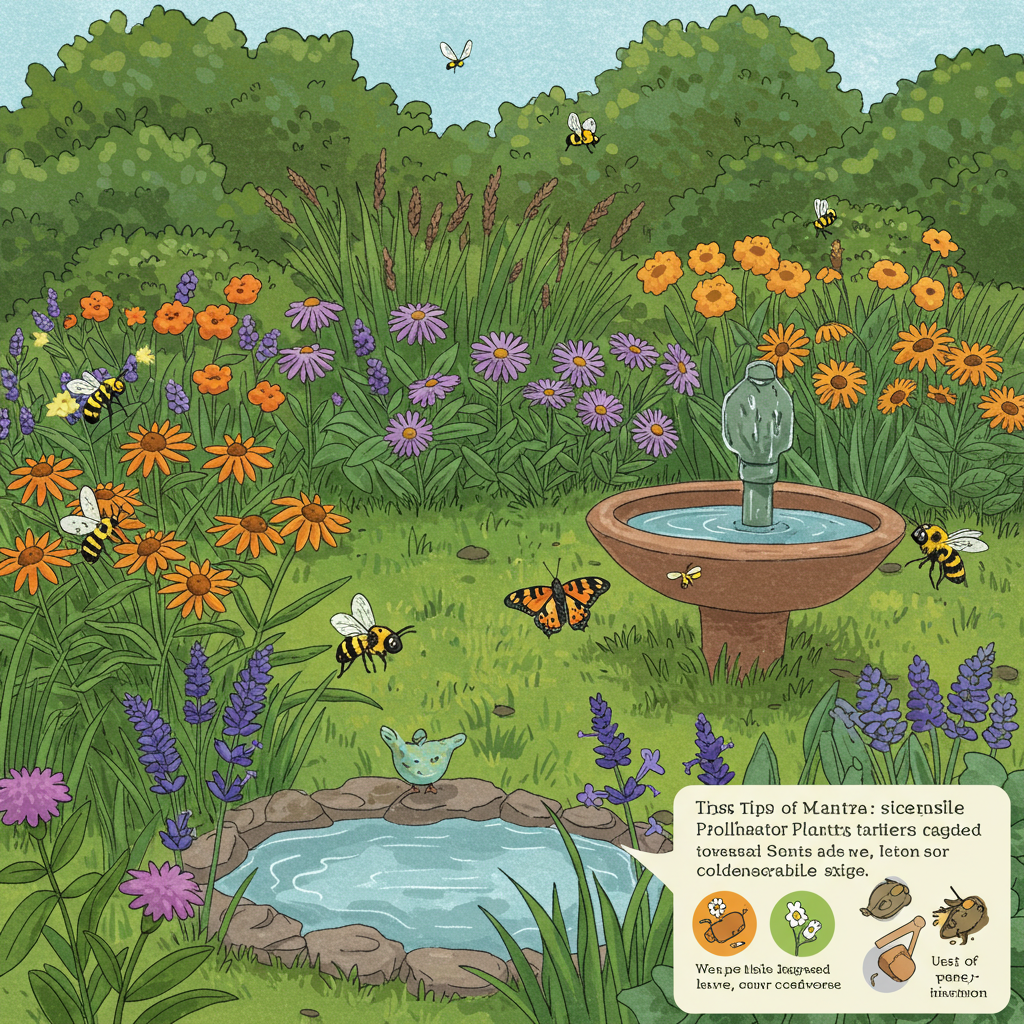If you’ve ever dreamt of a garden buzzing with life and color, creating a bee and butterfly garden is your perfect project. These vital creatures are not just beautiful visitors; they play a crucial role in our ecosystem, helping plants reproduce and ensuring the food we eat reaches our tables. Luckily, attracting pollinators to your outdoor space is easier than you might think, even for beginner gardeners. This guide will walk you through simple steps to transform your garden into a thriving haven for bees and butterflies, benefiting both nature and your green thumb.
Why Create a Bee and Butterfly Garden?
The benefits of pollinator gardens extend far beyond their beauty. Pollinators, including bees, butterflies, moths, hummingbirds, and beetles, are responsible for fertilizing over 75% of the world’s flowering plants and about 35% of global food crops. Without them, our ecosystems would suffer, and our food supply would dwindle. By building a bee and butterfly garden, you’re not just planting flowers; you’re contributing to biodiversity, supporting local wildlife, and enjoying a vibrant, dynamic landscape right in your backyard.

Designing Your Dream Pollinator Paradise
Thoughtful butterfly garden design is key to success. You don’t need a huge space; even a small balcony or a corner of your yard can become a pollinator hotspot.
Location, Location, Location
Most pollinator-friendly plants, and the pollinators themselves, thrive in sunny spots. Aim for an area that receives at least six hours of direct sunlight per day. Consider placing your garden where it’s somewhat sheltered from strong winds, providing a more comfortable environment for delicate butterflies and bees to feed.
Choosing the Right Plants
Selecting pollinator friendly garden plants is perhaps the most exciting part! The goal is to provide a continuous food source from spring to fall. Here’s what to consider:
- Go Native: Native plants for pollinators are often the best choice because they are perfectly adapted to your local climate and soil, require less maintenance, and have evolved alongside local pollinator species. They are what your local bees and butterflies recognize and prefer.
- Variety is Key: Offer a diverse range of flower shapes, sizes, and colors to attract different types of pollinators. Flat, open flowers are great for short-tongued bees, while tubular flowers are perfect for butterflies and hummingbirds.
- Best Flowers for Bees: Bees love plants like lavender, borage, hyssop, coneflowers, sunflowers, and clover. They are especially drawn to purple, blue, yellow, and white flowers.
- How to Attract Butterflies to Your Garden: Butterflies are attracted to bright colors (reds, oranges, purples) and need landing platforms. Good choices include coneflowers, zinnias, asters, phlox, and of course, milkweed for monarchs. For plants that attract monarch butterflies, milkweed (Asclepias species) is essential as it’s their only host plant for laying eggs.
- Year-Round Pollinator Plants: Try to select plants with staggered bloom times so something is always flowering. Early spring bloomers like crocuses and hellebores provide crucial food after winter, while late fall asters and sedum offer nectar before winter sets in.
- Shade Loving Pollinator Plants: If you have shady areas, don’t despair! Some plants like bleeding hearts, hostas, astilbes, and native wild ginger can still provide resources for pollinators.
- Avoid Hybrids: Many highly hybridized flowers have been bred for aesthetics, often at the expense of pollen and nectar. Stick to single-petaled varieties or heirloom plants when possible.
Beyond Flowers: Creating a Bee Habitat and More
A truly welcoming pollinator garden offers more than just food. It provides water and shelter, too.
Water Sources
Pollinators get thirsty! A pollinator watering station can be as simple as a shallow dish with pebbles or marbles, allowing bees and butterflies to drink without falling in. Ensure the water is regularly refreshed to prevent mosquito breeding.
Shelter and Nesting Sites
- Leave Some Areas Wild: A small patch of undisturbed bare soil is vital for ground-nesting bees. Leaf litter and brush piles provide shelter for many beneficial insects.
- Bee Houses: Consider adding a bee house (also called an insect hotel) for solitary cavity-nesting bees. Ensure it’s well-maintained and clean.
- Host Plants for Caterpillars: Remember, if you want butterflies, you need caterpillars! Plant specific host plants that provide food for their larvae, like milkweed for monarchs, parsley/dill/fennel for swallowtails, and willow for viceroys.
Embrace Organic Gardening
Practicing organic gardening for pollinators is crucial. This means avoiding pesticides and herbicides, which can be deadly to bees, butterflies, and other beneficial insects. Embrace natural pest control methods and let your garden’s ecosystem find its balance.

Easy Pollinator Garden Ideas and Maintenance Tips
Even small pollinator garden ideas can make a big impact. A few pots on a patio filled with lavender or zinnias can start your journey. The key is to provide the essentials that answer the question: what do pollinators need in a garden? Food, water, and shelter in a safe, chemical-free environment.
- Clustering: Plant flowers in clusters or drifts of the same type. This creates a larger visual target for pollinators and allows them to forage more efficiently.
- Deadheading (Sometimes): While deadheading (removing spent blooms) can encourage more flowers, consider leaving some seed heads for birds and overwintering insects.
- Winter Care: Don’t be too tidy in the fall! Leaving spent plant stems and leaf litter over winter provides crucial shelter and nesting sites for many beneficial insects, including some bee species.
- Observe and Learn: Spend time in your garden, watching which plants attract the most visitors. This will help you refine your choices for future seasons.
Creating a bee and butterfly garden is a rewarding journey that connects you with nature and supports the environment. With a little planning and care, your garden can become a vibrant, buzzing, and fluttering sanctuary that brings joy to you and sustains our precious pollinators for years to come. Start small, learn as you go, and enjoy the beauty you’ve helped create!
Frequently Asked Questions
What are the best plants for a beginner pollinator garden?
For beginners, some of the best pollinator-friendly plants include coneflowers, zinnias, marigolds, lavender, borage, and sunflowers. These are generally easy to grow, widely available, and highly attractive to a variety of bees and butterflies.
How often should I water my pollinator garden?
While the ideal amount varies by plant, soil, and climate, most pollinator gardens benefit from deep, infrequent watering. Aim for about 1 inch of water per week, either from rain or irrigation. Check soil moisture before watering to avoid overwatering.
Do I need a big garden to attract pollinators?
Absolutely not! Even a few pots on a balcony or a small bed in a corner of your yard can provide valuable resources for pollinators. Focus on dense plantings of highly attractive flowers to maximize impact in a small space.
Are all bees good for the garden?
Yes, almost all bees are beneficial! While honey bees are well-known, native bees (like bumblebees, mason bees, and leafcutter bees) are often even more efficient pollinators and are crucial for local ecosystems. Creating a diverse habitat supports all types of beneficial bees.
How can I protect pollinators from pests?
To protect pollinators, avoid using synthetic pesticides, herbicides, and fungicides. Instead, embrace organic gardening practices, encourage natural predators, use companion planting, and hand-pick pests when necessary. Read labels carefully if you must use any products, opting for organic and targeted solutions only when essential.
